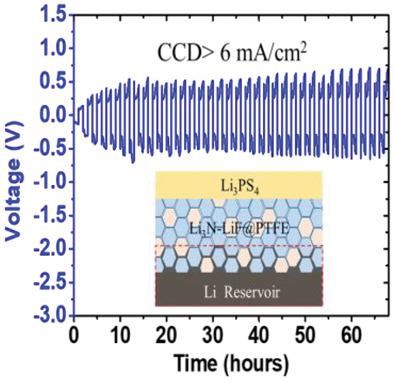当前位置:
X-MOL 学术
›
Adv. Mater.
›
论文详情
Our official English website, www.x-mol.net, welcomes your
feedback! (Note: you will need to create a separate account there.)
Solid‐State Electrolyte Design for Lithium Dendrite Suppression
Advanced Materials ( IF 27.4 ) Pub Date : 2020-10-09 , DOI: 10.1002/adma.202002741
Xiao Ji 1 , Singyuk Hou 1 , Pengfei Wang 1 , Xinzi He 1 , Nan Piao 1 , Ji Chen 1 , Xiulin Fan 1 , Chunsheng Wang 1, 2
Advanced Materials ( IF 27.4 ) Pub Date : 2020-10-09 , DOI: 10.1002/adma.202002741
Xiao Ji 1 , Singyuk Hou 1 , Pengfei Wang 1 , Xinzi He 1 , Nan Piao 1 , Ji Chen 1 , Xiulin Fan 1 , Chunsheng Wang 1, 2
Affiliation

|
All‐solid‐state Li metal batteries have attracted extensive attention due to their high safety and high energy density. However, Li dendrite growth in solid‐state electrolytes (SSEs) still hinders their application. Current efforts mainly aim to reduce the interfacial resistance, neglecting the intrinsic dendrite‐suppression capability of SSEs. Herein, the mechanism for the formation of Li dendrites is investigated, and Li‐dendrite‐free SSE criteria are reported. To achieve a high dendrite‐suppression capability, SSEs should be thermodynamically stable with a high interface energy against Li, and they should have a low electronic conductivity and a high ionic conductivity. A cold‐pressed Li3N–LiF composite is used to validate the Li‐dendrite‐free design criteria, where the highly ionic conductive Li3N reduces the Li plating/stripping overpotential, and LiF with high interface energy suppresses dendrites by enhancing the nucleation energy and suppressing the Li penetration into the SSEs. The Li3N–LiF layer coating on Li3PS4 SSE achieves a record‐high critical current of >6 mA cm−2 even at a high capacity of 6.0 mAh cm−2. The Coulombic efficiency also reaches a record 99% in 150 cycles. The Li3N–LiF/Li3PS4 SSE enables LiCoO2 cathodes to achieve 101.6 mAh g−1 for 50 cycles. The design principle opens a new opportunity to develop high‐energy all‐solid‐state Li metal batteries.
中文翻译:

用于抑制锂枝晶的固态电解质设计
全固态锂金属电池由于其高安全性和高能量密度而备受关注。但是,固态电解质(SSE)中锂枝晶的生长仍然阻碍了其应用。当前的工作主要旨在降低界面阻力,而忽略了SSE的固有树突抑制能力。本文研究了锂枝晶的形成机理,并报道了无锂枝晶的SSE标准。为了实现高的枝晶抑制能力,SSE应该是热力学稳定的,并且具有较高的抗Li界面能,并且它们的电子电导率应低,离子电导率应高。冷压的Li 3 N–LiF复合材料用于验证无锂枝晶的设计标准,其中高离子导电锂3 N减少了Li电镀/剥离超电势,具有高界面能的LiF通过增强成核能并抑制Li渗透到SSE中来抑制树枝状晶体。李3上立的N- LiF层涂层3 PS 4 SSE实现了>6毫安厘米创纪录的高临界电流-2即使在6.0毫安cm的高容量-2。库仑效率在150个循环中也达到了创纪录的99%。Li 3 N–LiF / Li 3 PS 4 SSE使LiCoO 2阴极达到101.6 mAh g -150个循环。设计原理为开发高能全固态锂金属电池提供了新的机会。
更新日期:2020-11-17
中文翻译:

用于抑制锂枝晶的固态电解质设计
全固态锂金属电池由于其高安全性和高能量密度而备受关注。但是,固态电解质(SSE)中锂枝晶的生长仍然阻碍了其应用。当前的工作主要旨在降低界面阻力,而忽略了SSE的固有树突抑制能力。本文研究了锂枝晶的形成机理,并报道了无锂枝晶的SSE标准。为了实现高的枝晶抑制能力,SSE应该是热力学稳定的,并且具有较高的抗Li界面能,并且它们的电子电导率应低,离子电导率应高。冷压的Li 3 N–LiF复合材料用于验证无锂枝晶的设计标准,其中高离子导电锂3 N减少了Li电镀/剥离超电势,具有高界面能的LiF通过增强成核能并抑制Li渗透到SSE中来抑制树枝状晶体。李3上立的N- LiF层涂层3 PS 4 SSE实现了>6毫安厘米创纪录的高临界电流-2即使在6.0毫安cm的高容量-2。库仑效率在150个循环中也达到了创纪录的99%。Li 3 N–LiF / Li 3 PS 4 SSE使LiCoO 2阴极达到101.6 mAh g -150个循环。设计原理为开发高能全固态锂金属电池提供了新的机会。

































 京公网安备 11010802027423号
京公网安备 11010802027423号